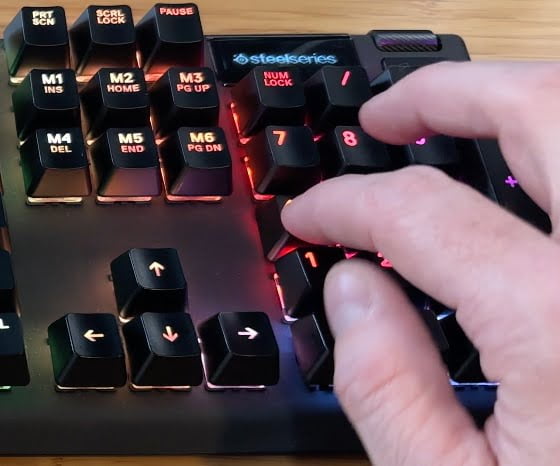Is the numeric keypad an essential component of modern keyboards or an unnecessary addition?
This question becomes increasingly relevant in an era where streamlined technology and minimalistic setups are increasingly preferred.
While numeric keypads offer convenience for rapid numerical input, they also occupy valuable desk space and limit how compact a keyboard can be.
I recently switched from a full-sized keyboard with a number pad down to a 65% keyboard without one.
I didn’t think I would miss the numpad at all, but I caught myself reaching for it quite often on the first day without it. I soon realized that I underestimated the value of the numeric keyboard.
Yet, at the same time, I was also enjoying the extra desk space. I also knew that, over time, I would become more accustomed to using the number keys at the top.
I decided to weigh the pros and cons of using a numeric keypad against a compact keyboard.
So, let’s explore the necessity of numeric keypads in today’s evolving workspaces, balancing functionality with the pursuit of simplicity.

The Efficiency of Numeric Keypads
In a world driven by efficiency, the numeric keypad stands unmatched for manual number entry.
Using voice to input information on smartphones and computers has made significant strides in recent years. However, given the wide variety of use cases for the numeric keypad, voice input is still far from competition with keypads.
The numbers at the top of the keyboard are relatively easy to type. Still, it’s widely known that a skilled touch typist can almost always enter numerical information (especially when operators are involved) much faster using the numeric keypad than with the numbers at the top.
I did my comparison tests, which also supported this idea. I was nearly three times faster using the numeric keypad with the numbers at the top.
If you work with long numbers regularly, numpads are essential. Accountants, programmers, and data entry clerks should avoid opting for compact keyboards instead of full-sized ones. If your laptop doesn’t have one – you better pick up a Bluetooth model.

Aesthetic Versus Utility
On the other hand, desk space is in high demand. The numpad’s default functions can be replicated using other keys, and smartphone usage is increasing.
It makes sense for users who seldom use the numeric keypad to question its prominence in our workstations.
There is even a study that supports minimalism in the workplace as reducing clutter aides in cognitive performance.
Additionally, who doesn’t like a fresh, clean workspace aesthetic?
The question is whether or not its efficacy makes up for its bulkiness.
The Macropad Option
Have you ever heard of a macro pad? As I’m writing this article, it still needs a Wikipedia page.
A macropad is a programmable small keyboard that is becoming popular among developers, gamers, and run-of-the-mill nerds like me.
You can turn your numeric keypad into one to use as a media player or to quickly open applications.
You can program the buttons to do whatever you want – open applications, run macros, type emojis. They allow you to be even lazier on a computer than you already are – but also more efficient.
Did you know you can turn your numpad into a macropad?
You only need to reprogram your keys and get new keycaps to match.
If more people knew about the alternative uses for numpads, they wouldn’t be so quick to dispose of them.
Ergonomics and Clutter
The discussion on the necessity of numeric keypads isn’t just about their utility for numerical input; it extends into the realms of workspace ergonomics and aesthetic minimalism. While the extra desk space afforded by eliminating the numpad is undeniably appealing, it’s crucial to consider the ergonomic implications this decision entails.
Ergonomics: A Dual Perspective
For many, the numpad is an indispensable tool that enhances typing speed and accuracy, especially for those whose work involves frequent numerical data entry. For those users, the ergonomic benefits of numpads are particularly pronounced. The design of the numpad allows for efficient, comfortable typing of numbers, with minimal movement required from the standard typing position. Its design reduces strain on the hands and wrists, making it a vital feature for maintaining productivity over long periods.
However, the presence of a numpad can also have potential downsides in terms of ergonomics. For right-handed users, a full-sized keyboard with a numpad necessitates extending the arm further to the right to use the mouse. This increased reach can lead to an asymmetrical sitting posture, potentially contributing to discomfort or strain over time. Such ergonomic concerns are significant for users who spend less time entering numbers and more time navigating with a mouse.
The Minimalist Aesthetic and Desk Space
In the modern pursuit of clean, uncluttered workspaces, the value of desk real estate has never been higher. The minimalist aesthetic favors compact, streamlined devices that maximize functional space without sacrificing form. In this context, the numpad, often seen as redundant or infrequently used, becomes a candidate for removal in the quest for a tidier desk.
Compact keyboards without numpads offer a sleek alternative, aligning with the minimalist design ethos while providing more room for mouse movement and other desk activities. This shift towards minimalism isn’t merely about aesthetics; it’s about optimizing the workspace for comfort, efficiency, and well-being.
Balancing Ergonomics with Minimalism
The decision to include or exclude a numeric keypad from one’s setup thus balances ergonomic considerations with aesthetic preferences and workspace needs. For individuals in professions reliant on frequent numerical input, the ergonomic advantages of a numpad may outweigh the benefits of additional desk space. Conversely, for those who prioritize a minimalist setup and use numbers less frequently, the ergonomic benefits of a compact keyboard and the extra desk space it provides might be more appealing.
In conclusion, choosing between a full-sized keyboard with a numpad and a compact alternative without one is deeply personal, hinging on individual work habits, ergonomic needs, and aesthetic preferences.
If you’re on the hunt for a new keyboard, Wired.com has a detailed article on choosing the best keyboard depending on your situation.
As we navigate the evolving landscape of workplace ergonomics and design, the numpad is a focal point in the broader conversation about how we define efficiency, comfort, and style in our work environments.





